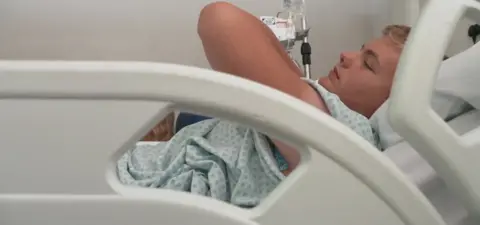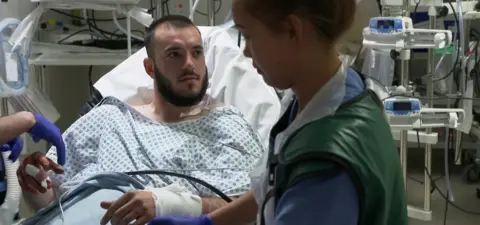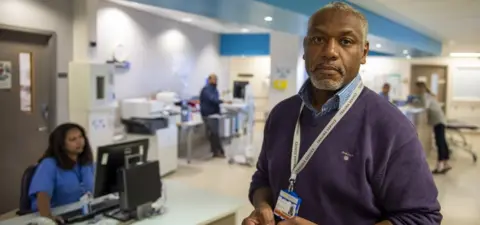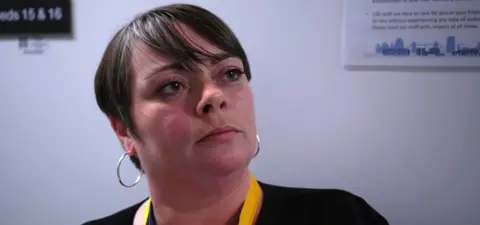Knife crime: Inside the London hospital treating the victims
 BBC
BBCWarning: Graphic language and description of injury
There were almost 15,000 knife crimes recorded in London last year - the highest since records began. Clive Myrie spent several weeks at the Royal London Hospital's trauma unit, where many of the victims are treated.
"People who carry knives are pussies," says Lucas.
Lucas is at his home in Essex. At 6ft 1in, he's a big lad at just 16 years old. He lifts up a loose fitting T-shirt to reveal a neat incision wound about 6in long, running from his sternum down to his belly button.
It's healing well, and was made by a surgeon in a lengthy operation to repair an attacker's stab wound that pierced his liver. A group of teenage robbers had tried to steal his bike and phone.
"It wasn't a fair fight," he says. "I had my fists, they had a knife. They're cowards."
I first came across Lucas 10 days earlier, at the Royal London Hospital in Whitechapel. A resuscitation team of doctors was trying to save his life. But this wasn't what you see on TV, with lots of dramatic rushing around. The team was speedy, but also calm and methodical, stabilising Lucas's condition, stemming the blood loss, and monitoring his vital signs.



He was fully conscious, though finding it difficult to speak, as the surgeon held his hand and assured him everything would be all right. But Lucas's mother Julia was far from all right, as her son struggled to ask for water. A nurse moistened his lips. Lucas was not allowed to drink before surgery.
Julia said she wasn't going to cry, she had to remain strong for Lucas. "I got the phone call and they said your son has been attacked and stabbed," she told me. "I couldn't believe it. They just stabbed him."


Trauma ward
For several weeks over a three-month period at the Royal London, we watch paramedics, doctors and nurses deal with a steady flow of knife attack victims.
The number of attacks averages two a night, their punctured bodies patched up before our eyes. For the staff this is normal, routine. The world they inhabit is appalling, but it's an environment one nurse says matter-of-factly she's "trained to inhabit".
One beautiful morning with the sun reflected in the sheet glass facade of the Royal London, Fazia, one of the nurses in charge, raises an eyebrow and tells us to "get ready".
"The sun is out, the kids are outside, it's a Friday, it's summer holidays. That almost always means stabbings," she says. "They're all out, some of the busiest times of day during school time is right after school ends, so imagine what happens when kids are out late because it's light and it's summer holidays. Chaos!"
One particularly warm night, after we film several stabbing victims in the resuscitation area, another on-duty nurse, Arnie, talks about the effect of seeing the aftermath of so much violence.
"It doesn't affect me, I get on with my life at home. Of course it's bad, but you know, these guys think it's normal anyway."
I wonder if it makes the staff fearful, but Arnie says it doesn't.
"It's sad, yes, but they are normally nice to me, they are nice kids. I don't see their life outside this hospital. Sometimes you get some bad ones, who are angry, but that's like everywhere, you get good ones and bad ones."
It is weird taking a peek into this world. Seeing medical staff remaining detached despite the carnage all around, and seeing the injured youngsters they help, mainly teenagers, some traumatised by their experiences, some energised by it.
One night, about 22:00, a 15-year-old who we'll call "Reece" (not his real name), hobbles down the corridor of the trauma ward. Chest drain in one hand, his mobile phone in the other, he wants to know why our cameras are in the hospital. He notices a BBC badge. "Oh, BBC man! Old man TV," he says with a laugh.
Coming down the opposite corridor is another patient with stab wounds. They compare scars, Reece shows the four slashes he took to his upper back, and the other boy shows the deep wounds on his legs. They share a laugh about how they've been cut up.
Reece says that once he gets out of hospital, he will "get back on the road" (re-engage in some sort of criminal activity). "How am I gonna make any money? Who gonna look after me?" He continues to laugh. "Look at the stitches man, it looks sick! I'm gonna snap it, innit."
He asks his friends to take a picture of him in his gown with his chest drain. They post it online and instantly people are commenting.
To Reece, the idea that he'd leave his life "on the road" is bizarre. He says he has no other options.



For many of these young men, their choices in life are limited.
For Reece, there are no parents on the scene and he's been in and out of care homes.
Later that night, as he sits in reception, an older man walks in, wearing a flashy tracksuit and shiny trainers. Reece knows him and his demeanour suggests he respects him - there's a deferential tone in his conversation.
It seems this man is there to remind Reece of his outside life - he had been due to appear in court.
When the man notices our camera, he starts giving what feels like a confected speech, about how this is Reece's chance to change his life. The two then go outside and when Reece returns, he reveals in his pocket a bag full of weed. He says it's just been given to him.
It's a reminder to Reece - who has sold drugs in the past - yes, you've been stabbed, but you survived, so remember what it is that puts food on your table and trainers on your feet.
Everyone we see needs major surgery. Thankfully, everyone survives. The wounds vary - slashes across an arm, a cut across someone's face, single stab wounds to chests or backs, frenzied repeat plunges of blades to someone's buttocks, often by multiple attackers.
Some of the assaults are during robberies. One victim is a bouncer slashed just above his mouth because he wouldn't let someone into a club. Others are kids caught between rival gangs - many are assaults during gang fights. If two victims are from rival gangs, they have to recuperate in separate wards, watched by police officers.
There is a bravado from some of the patients. Their wounds are badges of honour. But often the day after surgery brings clarity and reflection. The euphoria of survival gives way to crushing realities. Is it safe for them to return home? Are their families in danger? Are they marked for good?



Michael is admitted in an ambulance one night for what he says is his 12th stab attack. A knife wound has damaged tendons in the 24-year-old's left arm, and severed an artery in his wrist. It is annoying, he says - painful to be sure, but simply an inconvenience.
"This is London," he says, as nurses try to draw blood and administer morphine. "What am I meant to do, stay in my house? It's part of growing up in London and living in London."
A few days later when he's discharged, he says that he understands why people carry knives.
"It's to survive, if you know other people are rollin'," he says. "I can't say to someone, don't carry a knife, if they're feeling scared on the street. My little brother who's 21 has been stabbed. He's been arrested for carrying. It's his choice."


The surgeon
Many of the people we see at the Royal London end up on consultant surgeon Martin Griffiths's operating table. At 53 he is a trauma veteran, having worked for several years with severe knife and gunshot victims.
The Royal London's trauma unit is one of the busiest in Europe. Medical personnel from the armed forces often visit, to get first-hand knowledge of treating severe wounds.



Griffiths thinks that assaults are becoming more brutal, more calculating, having seen the results in theatre. The aim is not to kill an adversary, but maim or disfigure.
"We're seeing more complex wounds in areas where bits join together on the body, junctional areas," he says, "like the neck and the groin, and that suggests a movement towards more severe wounds and more numbers of wounds. We're seeing more victims with multiple injuries."
One night, a 17-year-old is admitted with several knife wounds to his buttocks. He's in a bad way, but his chances of survival are high. The surgeon thinks the attackers were trying deliberately to damage the victim's rectal area, to maim him and possibly force him to suffer the indignity of having to use a colostomy bag for the rest of his life.
"I hope it's just a blip," says Griffiths, "but I worry there's a change in attitude towards knife injuries. That people are becoming better educated in how to cause damage."
The trauma team at the Royal London are preparing a paper looking into the issue, and its results will be made public soon. Griffiths has been appointed the NHS's first clinical director for violence reduction.
"Why not try to talk to these young kids while they're here, away from the street, and find out why they ended up in bad company in the first place?" he says.
"Once you find that out, you can tackle the issue and prevent that young person coming back to my operating theatre, or ending up in a morgue. A knife crime victim isn't just a problem we can fix, but a person we can help."
To combine surgical and pastoral care, Griffiths has given office space - within shouting distance of his own - to workers from the St Giles Trust, a charity which helps victims of violent crime adjust to changed lives.


St Giles Trust
Roisin Keville is one of three workers based at the Royal London. She says the stories she hears are often heartbreaking - of broken families, parents who are drug abusers or who are violent. Stories of poverty and deprivation, where validation comes from the street, and a sense of self-worth is offered by drug dealers flush with cash and kind words.



Identifying the wider problems in the lives of knife crime victims, and addressing those issues, has brought results. Re-admittance rates to the Royal London are down from 45% to just 1% in six years.
Keville and her colleagues talk to the young victims the day after surgery, or as soon as they're able to talk. Some don't want to discuss their lives to begin with, but most eventually open up.
One teenager tells Keville that six months before he joined a gang, he found out that the woman he'd always called his mum wasn't in fact his biological mother. His real mother had disappeared when he was a baby. From then on, his world fell apart.
Keville and her colleagues talk to the youngsters, then when they're discharged, help them find jobs, or get back into education or training.
Laveen Smith is one of the St Giles Trust case workers. She says that knife crime victims can suffer long after they have left hospital.
"Many just don't have any support," she says. "They're traumatised and mentally very fragile. I've been dealing with one young man who says he's all right, his wounds have healed, but he's been getting panic attacks and feeling a bit paranoid, and he's been hearing on the street that the person who attacked him is out there and might come back for him."
Griffiths says the success of the work done at the Royal London on tackling knife crime speaks for itself. But it takes time to help the young people involved and their families. His view is that good results don't come quickly - Griffiths suggests tackling solutions for knife crime could take a generation.
But working with youngsters and trying to understand their problems is the only effective way to proceed. To save lives and communities.


